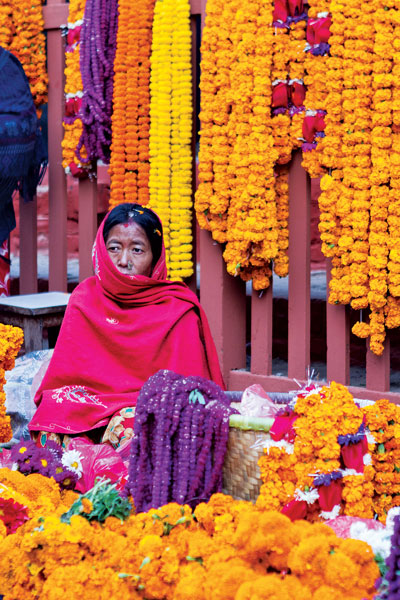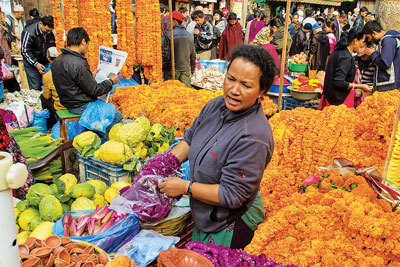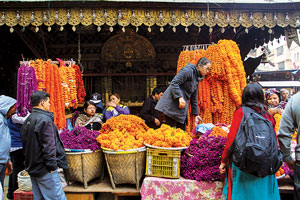
Flowers have been an integral part of Hindu rituals and practices. And one is left wondering why flowers are so important, after all? ECS Nepal makes an inquiry.
The harbinger of fortune, the carnival of colors, lights, flowers is heading its way towards Nepalese residing around the globe brining along with it joy, happiness and festivities. Every child’s much awaited time of the year and the one which brightens up our houses and lives is the festival Tihar. Also known as Deepawali, this is one of the prominent festivals of Hindus, celebrated under the Nepali month of Kartik.
In Hindu culture, people believe in performing rituals using different mediums. Tihar is enjoyed with a variety of food, display of light-works, colors of blessings and flowers like marigold (Sayapatri) and globe amaranth (Makhamali). Everything that comes from nature is supposed to have some significance towards human life. As it says, nothing happens without reason, use of these nature gifted flowers are braced under this principle. So, let us find out how these flowers emerge as a symbol of cultural value in the long run.
Sayapatri (marigold) is believed to have existed from the territory of southern Europe. Its tall, erect stems, long hairy leaves with margins and aromatic flavor make its own identity. Sayapatri are born to cope with moist soils and that’s the reason they are considered as the most versatile flowers. Marigold or more commonly Calendula has been used medicinally for centuries. From the primary days, this flower has been used to treat conjunctivitis, eczema, and gastritis, minor burns including sunburns, warts, cramps, coughs, and snake bites as well. Marigold contains a chemical enriched with anti-oxidants to protect body cells from damage caused by a chemical process called oxidation. Oxidation produces oxygen free radicals, and these free radicals cause in damage of human cells.
 Globe amaranth (Makhamali) is native of South America and Inner Asia that grows up to 24 inches in height with multiple colors such as purple, red, white, and pink. The flower includes ingredients used to make tea and can help recover human from normal illness to useful for the patients suffering from heart diseases. This flower has a specialty that it does not wilt for a long time even after it has been plucked from the main plant, even that it is kept away from sunlight. It is also medically proven that it contains medical properties like their seeds are found containing high fiber and low saturated fats.
Globe amaranth (Makhamali) is native of South America and Inner Asia that grows up to 24 inches in height with multiple colors such as purple, red, white, and pink. The flower includes ingredients used to make tea and can help recover human from normal illness to useful for the patients suffering from heart diseases. This flower has a specialty that it does not wilt for a long time even after it has been plucked from the main plant, even that it is kept away from sunlight. It is also medically proven that it contains medical properties like their seeds are found containing high fiber and low saturated fats.
In Hindu Culture, Makhamali and Sayapatri carry their own significance especially in Tihar. It is used to make garland for Brother’s Day (Bhai Tika). The fifth and last day of Tihar is called Bhai Tika before Kaag Tihar, Kukur Tihar, Laxmi Puja and Govardan Puja and is observed by sisters applying tika to the foreheads of their brothers to ensure long life and thank them for the protection they provide in return. According to the Hindu myth, the god of death, Yamraaj once went to meet his sister Yamuna. At that moment, Yamuna, overwhelming with Joy and Happiness invited her brother with lots of decorations, healthy dishes, the garland of makhamali and sayapatri flowers and blessed tika on his forehead. Yamraaj, also offered his precious time to meet his lovely sister. Being so much overjoyed, Yamraaj gifted Yamuna a boon that whoever puts the tika and garland of flowers for that day will be surpassing death for that day. Since then, these flowers became an immense part of hindu culture. This flower is also used for decoration and medicinal purpose. Makhamali has a great storage property so it can be stored for even a year.
 On the other hand, Sayapatri is a very beautiful and valuable flower. Garlands of Sayapatri is used to decorate houses in Tihar, automobile decoration and also worn in Special occasion. The flower is used to worship Hindu deities especially Goddess Laxmi, the god of Wealth and Prosperity on the occasion of Deepawali. This flower is also used to make footprints of Goddess as a symbol of bless inside houses. Not only in Bhai Tika, Sayapatri is used in each day of Tihar for decoration purpose.
On the other hand, Sayapatri is a very beautiful and valuable flower. Garlands of Sayapatri is used to decorate houses in Tihar, automobile decoration and also worn in Special occasion. The flower is used to worship Hindu deities especially Goddess Laxmi, the god of Wealth and Prosperity on the occasion of Deepawali. This flower is also used to make footprints of Goddess as a symbol of bless inside houses. Not only in Bhai Tika, Sayapatri is used in each day of Tihar for decoration purpose.
Not only on the ground of Hindu Culture, have these precious flowers had their own significance across the world in different civilizations. The Marigold is said to have derived its name from “Mary’s Gold”, taken from the fact that early Christians placed flowers instead of coins on Mary’s altar as an offering. This flower is often used in festivities honoring Mary.
The marigold is likewise associated with the sun - being vibrant yellow and gold in color. The flowers are open when the sun is out. The marigold is also called the “herb of the sun”, representing passion and even creativity. It is also said that marigolds symbolize cruelty, grief and jealousy to show strong passion, being associated with the legendary brave and courageous lion. Its Victorian meaning, desire for riches, is probably consequent to the legends of the flower being Mary’s gold, depicting coins.
 While, this distinctive feature of Makhamali portrays a myth that just like the longevity of its endurance, the brothers of females who have been offered Makhamali, will have a long life.
While, this distinctive feature of Makhamali portrays a myth that just like the longevity of its endurance, the brothers of females who have been offered Makhamali, will have a long life.
Talking about the market, apart from locale, there are many Nepalese residing in foreign countries. Every Year the demand of garland of Makhamali and Sayapatri is increasing rapidly but because of the low production, the demands are then fulfilled by importing from other countries in huge price. Local people cannot reach customers and customers are left with no choice but to purchase from third party in soaring price. As the importance of these flowers can be seen not only in our culture, a perspective view should be put forth about the cultivation procedure, investment, cost and profit of Sayapatri and Makhamali. It is better to uplift our values and norms what bind us and other essentials what bind our culture.










